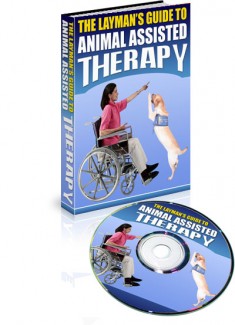 License Type: Private Label Rights
License Type: Private Label Rights  File Size: 87,951 KB
File Size: 87,951 KB File Type: ZIP
File Type: ZIP
 SKU: 52519
SKU: 52519  Shipping: Online Download
Shipping: Online Download
Ebook Sample Content Preview:
Chapter 3 - How to Become an AAT Specialist
Now that you understand how beneficial AAT is, you may have an interest in starting your own program or becoming an AA therapist. Fortunately, since the practice is now more commonplace than ever before, there are established guidelines that dictate who can offer AAT and how therapy should be conducted.
Standards Of Care
The American Kennel Club and Canine Good Citizen tests are often used to assess whether an animal meets the appropriate behavioral guidelines and socialization guidelines needed to provide supportive care.
Anyone participating in AAT must recognize that all care is very objective or goal-oriented, thus a licensed professional should supervise all therapy sessions. Typically, an animal therapist engages with a team of experts to ensure successful outcomes.
Before commencing a session, the therapist will discuss the goals and objectives of therapy with patients before practicing any treatment. Here are some strategic steps you can implement to get started with AAT:
First, find out if there is a local organization near you that offers training. Try to find a group that is nationally certified. Often you can find a group simply by conducting research on the Web, a local healthcare center, or veterinarian may be able to point you in the right direction.
Next, find out if your dog or other animal will qualify for participation. Most programs require dogs be at least one year before evaluation. Evaluations will include health evaluations, obedience and behavioral evaluations and temperament. Of these the temperament test is often the most telling, as it places the dog or animal purposely in a stressful or emotional environment then encourages a response. What most trainers look for is a dog that will remain neutral in a setting where chaos, crowding or other stressors may be present.
As an example, a dog may be exposed to a sudden loud noise. The evaluator will assess how much this stresses the animal and how the animal responds. Since the environments an animal will enter as a therapy dog are so diverse, it is important to asses how an animal will react. The goal here is to ensure the animal does not act in a violent or aggressive manner. Animal therapy sessions are truly enjoyable when you have an animal with a mild-mannered temperament.
Some dogs are more amicable than others. For example, some of the more popular breed of dog used in AAT include: Labradors, German Shepherds, Sheepdogs and Golden Retrievers.
Next, you will probably be assigned an evaluator to accompany you on observation visits, which is a time when you and your animal are objectively observed to see how comfortable you are and how you react in stressful situations. This step is a very important part of the process. We are often subjective about our own reactions to others, and about our pet’s abilities around others. An evaluator provides an objective review of your pet’s readiness to help others.
If you feel comfortable and your dog or other animal does as well, often you can proceed with certification. Keep in mind AAT typically refers to very formal treatment programs, where a handler works one-on-one with clients.
Good therapy pets are usually those that are calm and enjoy socializing with others. If you own an attack dog, a herder, or other boisterous animal chances are they are not a good choice or option as an animal assisted therapy pet.
What We Learned
Not every animal is ideally suited for pet therapy, nor is every pet owner a proper candidate to act as a volunteer or paid animal assisted pet therapist. Fortunately, with the increasing popularity of AAT, new standards have been established that outline the exact procedures one should follow if they want to become an animal therapist or if they want to train a pet as “pet” therapist.
If you have more questions about becoming an animal assisted therapist, there are many organizations that now offer training programs for people and pets alike.
Conclusions
Since the dawn of time human beings have used pets in various ways. Pet therapy is not something new, though it is something attracting more and more attention.
By nature, most pets are nurturing, caring and supportive. Many therapists are now using pets as part of routine practice. They are very capable of helping patients overcome disabilities, emotional barriers to communication and positive therapy and beneficial for patients suffering from isolation, depression or loneliness.
Not all pets are suitable for pet therapy. But, if you have an interest in training your dog or other pet as a “pet therapist” there are AAT training and certification programs throughout the nation that can assist you. Many of them are listed in our resources section. Pets truly are mans best friend.
Keep in mind you don’t have to own a pet to benefit from Animal Assisted Therapy. Many therapists have their own animals they bring to therapy sessions. Volunteers often bring their own pets to assisted living facilities or hospice, to act as companions or playful friends to those in need of comfort. This form of therapy can dramatically improve the quality of life of anyone, in a simple, easy and unique manner.
If you think you may benefit from AAT, talk with your healthcare provider and find out what types of therapy may be available near you. And don’t be surprised if the next time you visit your doctor, you find a dog sitting by his or her side. Tell your kids the same, because more and more animals are being introduced into ordinary classrooms to foster greater socialization and active learning.
- File Size:87,951 KB
- License: Private Label Rights
- Category:Ebooks
- Tags:2014 Ebooks With Audio Private Label Rights








